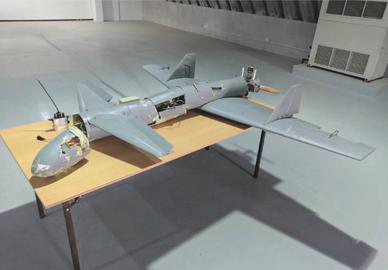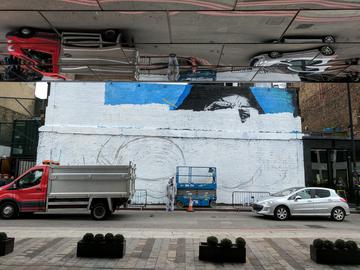According to a new report by the United Kingdom-based transparency group Conflict Armament Research (CAR), there is strong evidence that Iran is supplying Houthi rebels in Yemen with drones.
“We saw one complete system, six components of systems, and one engine that had been recovered from an attack against a radar system for a Patriot missile defense system,” says Tim Michetti of CAR, which has examined drones captured in Yemen by the United Arab Emirates’ Presidential Guard forces.
CAR researchers cite serial numbers on the drones’ components, as well as the engines and gyroscopes used, as evidence that the Houthis’ Qasef-1 drones are “a type within the Ababil-II family of drones” manufactured by Iran’s Aircraft Manufacturing Industrial Company, HESA.
Saudi Arabia and other Arab Gulf States have long accused Iran of supporting Yemen’s Houthi rebel movement militarily, but Iran has denied it.
“It's pretty safe to say that the evidence is mounting in terms of a supply chain that goes from Iran to Yemen,” says Alex Vatanka of the Middle East Institute. “There are those in Tehran who believe that the only way Iran can secure its interests in the region is to take the fight to the Saudis, and that Yemen is the exposed underbelly of Saudi Arabia, and they should go out there and poke it as much as they can.”
Proxy War in Yemen
Tension between Iran and the Arab Gulf States in Yemen emerged after 2011 Arab Spring protests caused President Ali Abdullah Saleh to step down in 2012.
Since then, Yemen has faced continual unrest, with groups loyal to the internationally recognized government of Saleh’s successor, President Abdrabbuh Mansour Hadi, facing off against Saleh supporters and the Houthi rebel movement, which claims to represent Yemen’s Zaidi Shia minority.
While Saudi Arabia and its neighbors on the Arabian Peninsula have sought to secure the Hadi government, Iran has increasingly voiced support for its opponents.
In 2015, a Saudi-led coalition of Arab Gulf states began a military campaign against the Houthi rebels, launching airstrikes that have killed thousands of people. The coalition has also imposed a blockade that has left much of the country in need of food aid.
The Houthi rebels, meanwhile, have deployed increasingly effective means of asymmetric warfare against the coalition, notably by using explosive-laden drones to attack expensive US-made Patriot missile defense systems used by the Saudi-led coalition.
The Houthis have displayed their drones publicly, and claim to have designed and manufactured them themselves. But Michetti says that doesn’t add up.
“What is telling,” Michetti says, “is the sophistication of what is being supplied and the application of these tools, using cheap drones to take out high value assets. That is sophisticated. The Iranian regime is intelligent and sophisticated, and it's completely within their capabilities.”
Locally, the Houthi strikes are referred to as “kamikaze” attacks, a reference to the Japanese Second World War tactic of flying explosive-laden fighter planes into US battleships and aircraft carriers.
But whereas Japanese pilots sacrificed their lives to hit American ships, the Houthi method is far more cost-effective.
“Using these drones, which can't cost more than $10,000 to manufacture, and deploying them against multi-million dollar patriot missile systems, over time that financial calculation would meet that goal of bogging down the Saudi-led coalition,” Michetti says.
CAR has also considered the seized drones’ alleged transit route, which would suggest they are entering Yemen from across the Persian Gulf.
“Six of these drones were reportedly smuggled overland from a truck that originated in Dubai, stopped in Oman, and then transited overland from Oman,” Michetti says. The truck is then believed to have traveled across a significant section of Yemeni territory before UAE forces seized it in Yemen’s central Marib province.
“If these things were manufactured by the Houthis,” Michetti says, “why would they manufacture them in Sana’a or wherever they claim to manufacture them, then disassemble them, and then put them on a truck that took a circuitous route way outside their territory? It just doesn't make sense.”
The Houthis’ Qasef drones, Michetti says, are slightly smaller than the Iranian Ababil models they closely resemble, but he believes this indicates they are designed for smuggling.
“If you are going to manufacture something, smuggle it into some place with the intention of having a third party reassemble it, you'd want something smaller, which is easier to get into a country that is under embargo.”
The Syrian Factor
The conflict in Yemen has emerged as a fourth front in a regional cold war between Iran and Saudi Arabia, each of which already supports proxies in Lebanon, Iraq, and Syria.
But for both countries, the contest in Yemen—which is one of the poorest nations in the Middle East—may really be about the war in Syria, where Iran has supported President Bashar al-Assad against a wide range of rebel groups, some of which have received support from Arab Gulf States.
For the Gulf State coalition, says Vatanka, Syria may be seen as a lost cause to be redeemed in Yemen. “You could argue the Gulf Arab states are pulling away from Syria because they look at that place as a losing proposition,” he says. “Instead, they are turning their attention to Yemen, making sure that Yemen does not end up becoming another Hezbollah-type bastion that is tied to Iran.”
Michetti sees a long-running Syrian factor in Yemen. “I think Iran’s goal in supporting the Houthis has been primarily to solidify the position of Bashar al-Assad in Syria,” he says. “One way of doing that was to distract any Arab nations that may have provided resources to anti-regime forces in Syria by distracting them in Yemen. The Syrian regime is in a much stronger position than it has been in a long time, and the Saudi-led coalition has found it increasingly difficult to extricate itself from the conflict there. In that reading of it, I think Iran has already won in a way.”
visit the accountability section
In this section of Iran Wire, you can contact the officials and launch your campaign for various problems




























comments